
Hawthornes- the haws are still available in Winter (my substitute for a photo of Saskatoons in winter)
Prelude
Early in December I was invited to take a meditative walk and see if something in the natural world caught my attention. What I especially noticed was how many Saskatoon berries were still on the bush. Most were dried like raisins. I ate a handful and found them full of taste. What a sweet surprise, I thought…after all, the birds, the squirrels, the bears and we humans ate our fill of Saskatoons in the summer, and yet, there were still some left over!! What abundance! How marvellous – to savour this summer taste as the days grow darker!
 A few weeks later, Robin Wall Kimmerer, published “The Service Berry: An Economy of Abundance” in Emergence Magazine. Wouldn’t you know it? The service berry is also called the Saskatoon berry! This excellent essay celebrates the abundance and gift of this “best of the berries”. Wall Kimmerer also explores gratitude, reciprocity and the gift economy using the Saskatoon bush as guide and teacher.
A few weeks later, Robin Wall Kimmerer, published “The Service Berry: An Economy of Abundance” in Emergence Magazine. Wouldn’t you know it? The service berry is also called the Saskatoon berry! This excellent essay celebrates the abundance and gift of this “best of the berries”. Wall Kimmerer also explores gratitude, reciprocity and the gift economy using the Saskatoon bush as guide and teacher.
This essay struck me as beautiful medicine for the next decade, as well as a call to action or perhaps (worded differently) – an invitation to respond creatively and “live into” the community Robin Wall Kimmerer envisions. While some of us are anxious to return to “normal”, I think many of us would qualify “normal”. The pandemic has enabled us to see ever more clearly how our culture of excess has not served us well, and how it has favoured some at the expense of so many others and so much else (including care of the earth). Robin Wall Kimmerer is a wise visionary and leader, who so clearly articulates the need for a change in our priorities and direction. She does so poetically. Even better, we can read the essay or listen to her read it to us, or both!!
Here’s the invitation:
Please consider accompanying me as I read and listen to Robin Wall Kimmerer’s essay “The Service Berry: An Economy of Abundance” over the next few months. I have divided it into 4 sections, simply because there are many ideas here and reading over a longer period of time allows us to sink into these ideas. We will take approximately a month to read and respond to each section.
I invite you to comment on a particular quote (or quotes) that stirred something in you.
I also invite you to respond creatively, if you feel called to do so. You might feel called to respond to one section and not another. Or to all four. Or to none. All are good.
What do I mean by responding creatively? Think of some of the creative people you know – people who decorate their homes with that special touch, poets, make up artists, beaders, ice lantern makers, cooks and bakers, welders, tattoo artists, wood workers, dancers, music makers, knitters and crocheters, story tellers, leaders in ceremony, healers, potters, sewers, seamstresses and quilters, entrepreneurs, song writers, mothers and fathers, aunties and uncles, graphic artists, tic toc creators, gardeners, worship leaders, cake decorators, photographers, people who dress with flair, nail artists, sculptors, gardeners, snow fort builders…the list could go on and on.
A creative response could also be an action – sharing a gift, taking care of a piece of land, nurturing a small garden, writing a letter, “paying it forward” in a way that nurtures connection. Receiving a gift could also be a creative response – for many of us receiving well is harder that giving or sharing. As Wall Kimmerer notes, we are receiving gifts all the time and sometimes we become alert or especially aware of a particular gift we have long taken for granted.
To some extent, we are already living into “an economy of abundance”. It feels to me that doing this together in response to Robin Wall Kimmerer’s essay brings a degree of intention and community which will make a difference for each of us, and perhaps ripple out.
Sharing Our Responses and Comments
Your comments and creative responses will be shared on a dedicated website (with your permission). I hope to get this website up this month (February 2021). I will send you the link to the website when it is available, and regular updates or reminders now and again. You can send your responses to me by email.
Other ways of becoming community may emerge naturally as we accompany each other in considering and living into Robin Wall Kimmerer’s ideas. If you have thoughts about how we might share our responses with each other, please send them on to me.
How To Join In
E- mail me at poachedeggwoman@gmail.com if you are interested in taking part in some way or have questions. You will receive an e-mail with a link to each section we are reading, and subsequent e-mails with links sharing how people are responding.
Feel free to share this with others who may be interested.
Here is a PDF of Section 1 of the essay – Robin Wall Kimmerer SECTION 1
Here is a PDF of Section 2 of the essay – Section 2 – Reading Robin’s Essay
Here is a PDF of Section 3 of the essay – Section 3- Robin’s Essay
Here is a PDF of Section 4 of the Essay- Section 4 PDF































